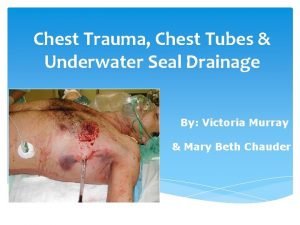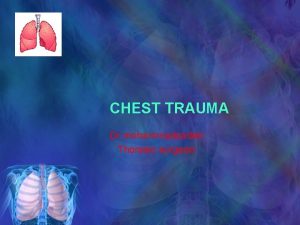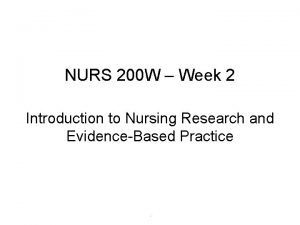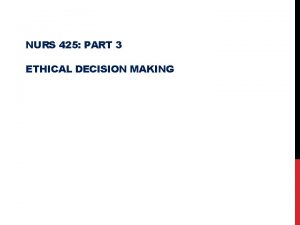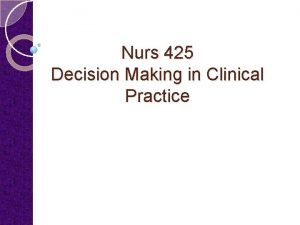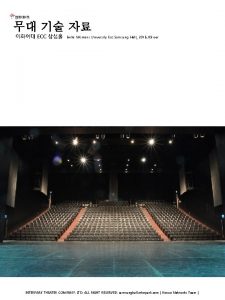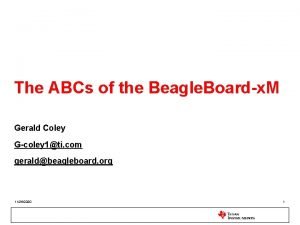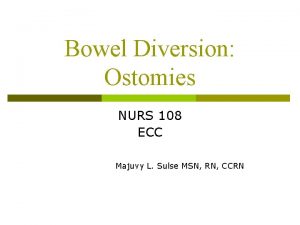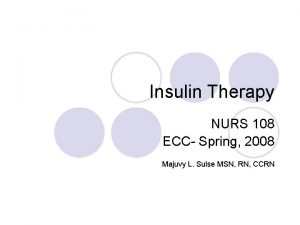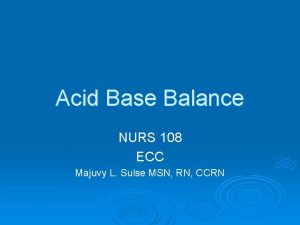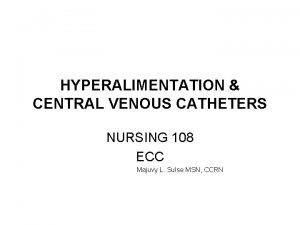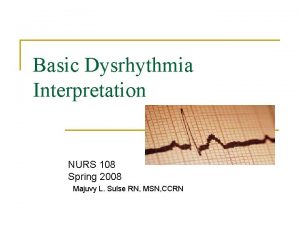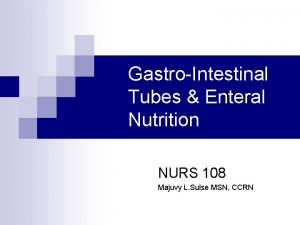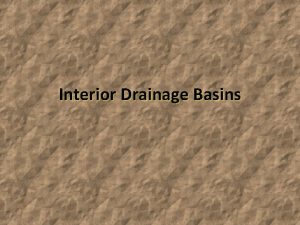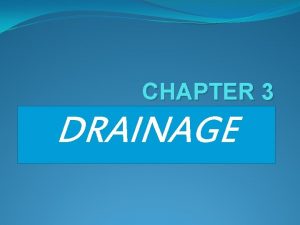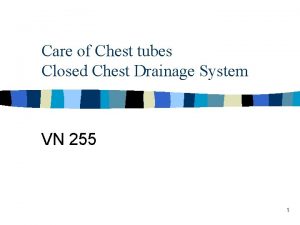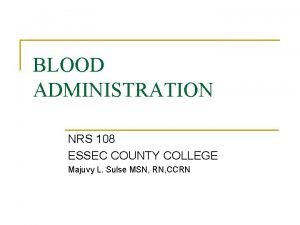Underwater Seal Chest Drainage NURS 108 ECC Majuvy















- Slides: 15

Underwater Seal Chest Drainage NURS 108 ECC Majuvy L. Sulse MSN, RN, CCRN, CNE

The Pleura

Conditions that alter pleural space n n n Pneumothorax Hemothorax Empyema Chylothorax Tension pneumothorax

Tension Pneumothorax

CLINICAL SIGNS n n n n Chest pain tachycardia tracheal deviation Air hunger hypotension cyanosis Respiratory distress Unilateral absence of breath sounds

Reasons for inserting a chest tube n n Allow drainage of the problem substance Restore normal intra-pleural pressure Permit expansion of lungs Promote adequate gas exchange

Sites for chest tube insertion Hemothorax -chest tube is inserted between the fourth to sixth intercostal space at the midaxillary line Pneumothorax- tube will be inserted into the second or third intercostal space in the anterior chest at the midclavicular line.

Chest Tube Drainage system n Three basic Principles n Gravity n n Positive pressure n n Causes air to flow from higher to lower level Positive pressure created by the air or fluid (>762)will seek to relieve itself to a lower pressure under the water (761) Suction n Subatmospheric pressure is reduced promoting air or fluid to move from higher to lower pressure rapidly

Chest Tube Drainage system Drainage bottle collection Water seal-(2 cm H 20) Suction bottle(20 cm H 20)

Chest Tube Drainage system n Drainage collection chamber n n Water- seal chamber n n Acts as one way valve Suction control chamber n n Receives fluid and air from chest cavity Amount of suction is regulated by the depth of the water not the amount of suction applied to the system Dry suction n A valve controls the amount of negative pressureno need for water in the suction control chamber

Nursing Care n n n Thorough lung assessment Keep water seal and suction at appropriate levels Monitor fluid drainage and evacuate n n n Suction chamber n n Continuous air bubbling=normal function Water seal chamber n n n 50 -200 ml/hr immediate post surgery(500 mlx 24 hrs) for mediastinal chest tube 100 -300 ml first 3 hours after insertion; no more than 1 L to 1200 ml of pleural fluid grossly bloody drainage x 24 hours then becomes serous and lesser in drainage Continuous air bubbling=air leak absence tidaling=blockage or lung re-expansion Don’t let patient lie on tubings-no loops

Nursing Care n n n Check patient status-encourage deep breathing and shoulder range of motion Never elevate drainage system above level of chest Do not strip or milk routinely Maintain aseptic technique when changing dressings Clamp tubes only for special procedures as changing drainage, air leaks or before removal of chest tubes If drainage system breaks, place distal end of tubing in sterile water container at 2 cm level

Nursing Diagnosis n n n n Knowledge deficit r/t chest tube (CT) Anxiety r/t presence of chest tube Impaired mobility r/t pain from CT Impaired skin integrity Risk for infection r/t invasive procedures Risk for ineffective breathing pattern r/t collapsed lung, malfunction of CT Impaired gas exchange r/t air & fluid accumulations in the pleural space Ineffective airway clearance r/t incisional pain

Removal of chest tubes n Indications n n n Fluid drainage ceased Lung re-expansion Nursing role n n n Monitor for tension pneumothorax Have pt do a valsalva maneuver as CT is removed Apply airtight dressing Observe for drainage & reinforce if necessary Observe for respiratory distress & pneumothorax

Complications n n n Malposition of tube Re-expansion pulmonary edema Infection Pneumonia Frozen shoulder
